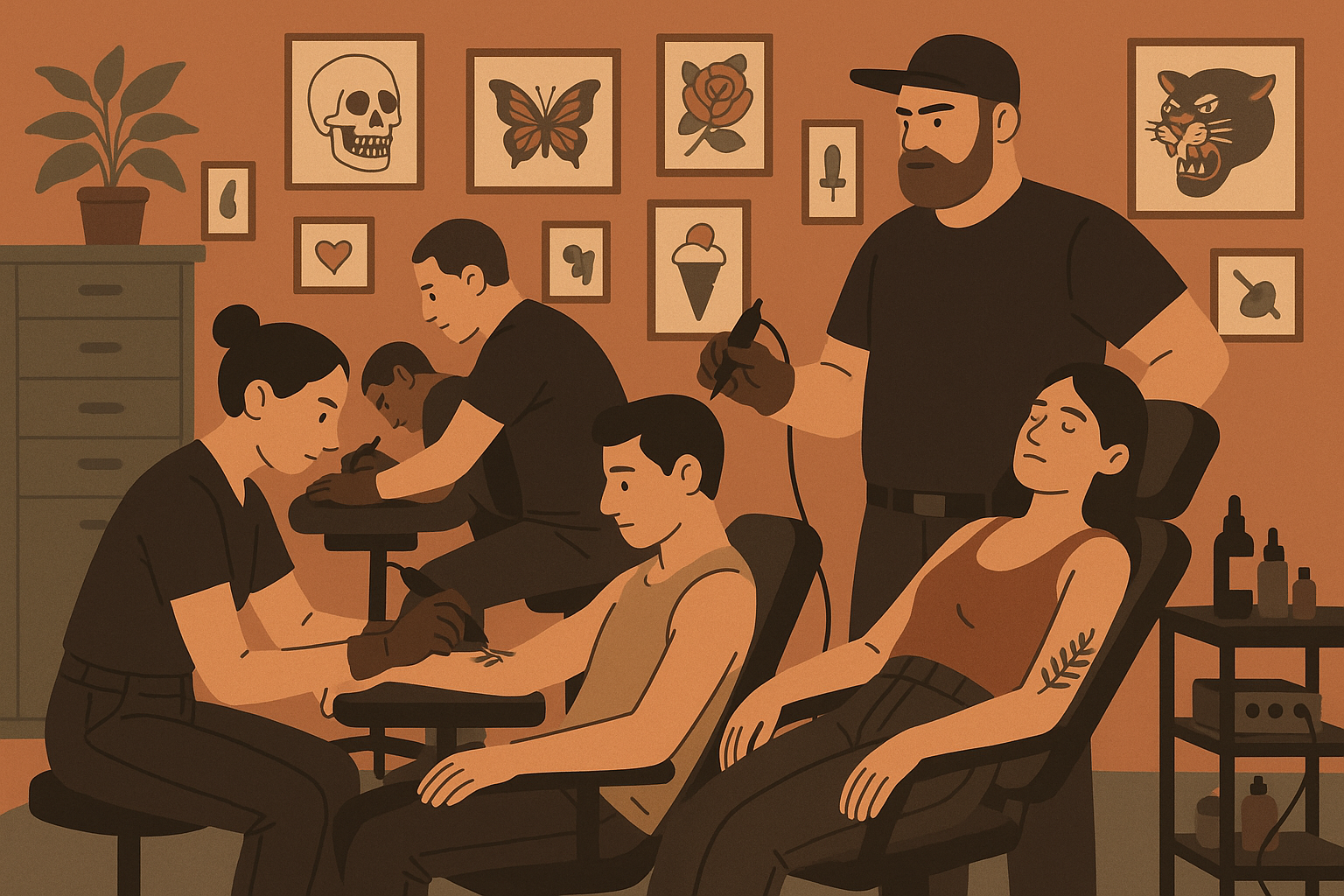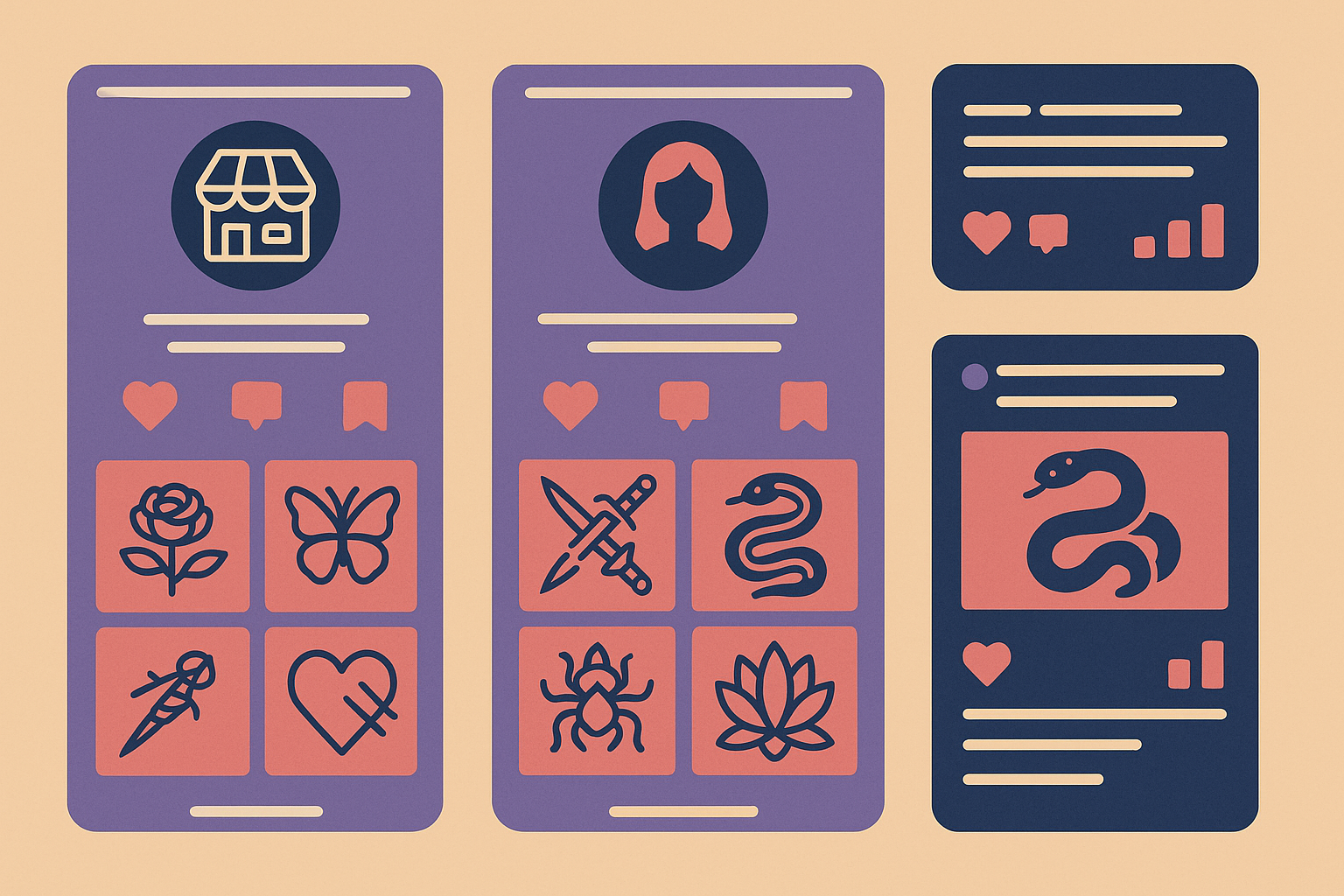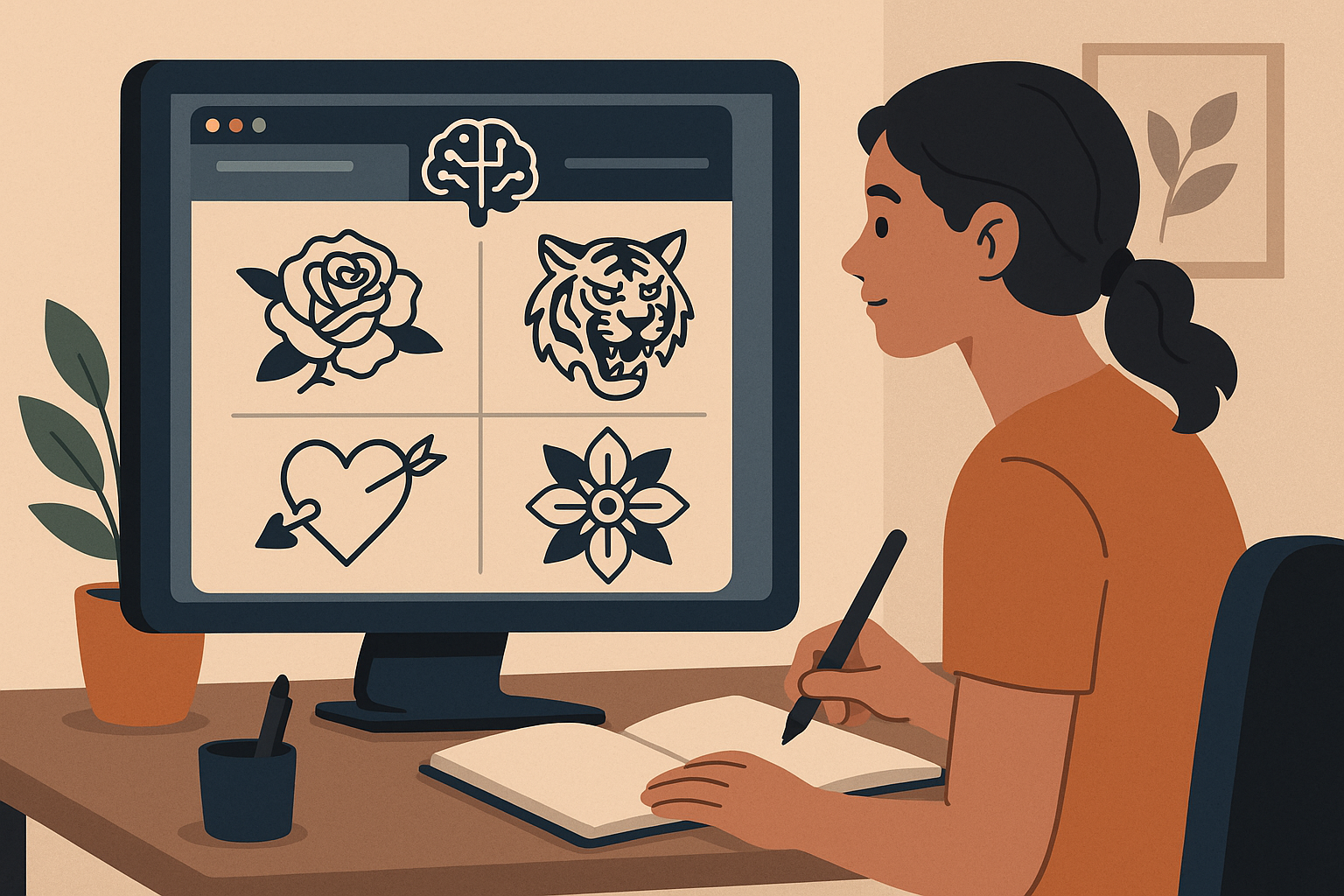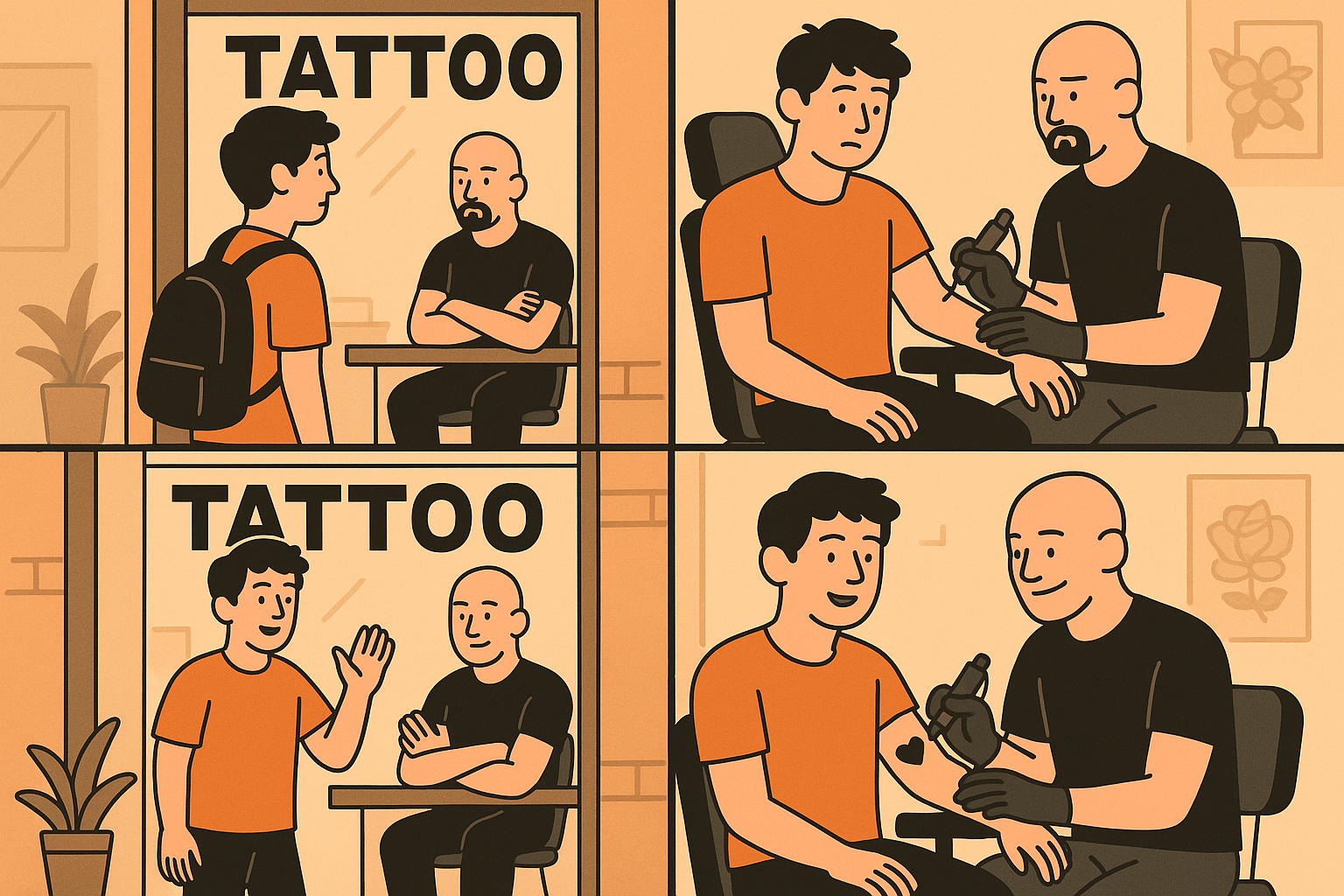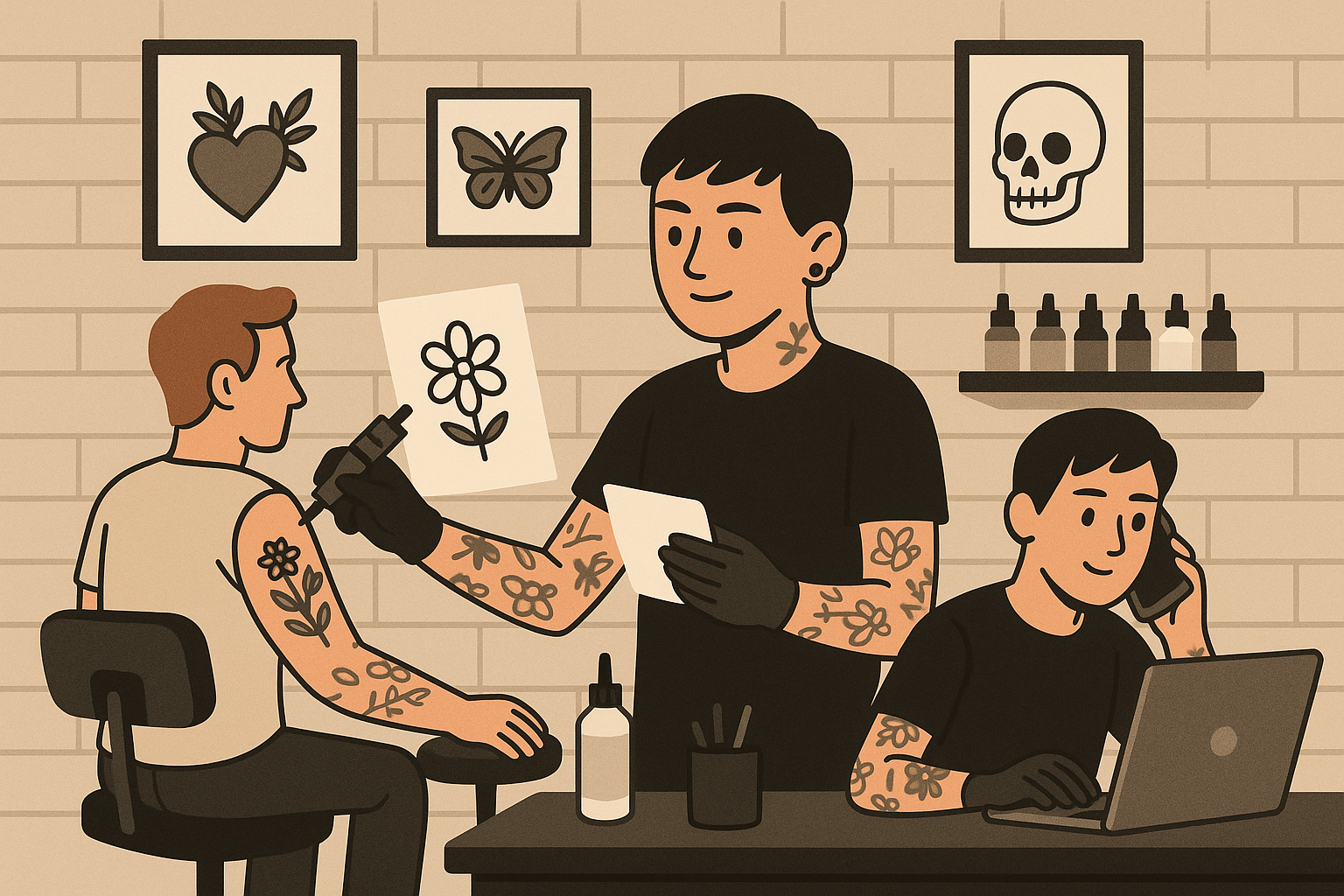Tattoo Apprenticeship Secrets: What Nobody Tells You About Breaking Into the Industry
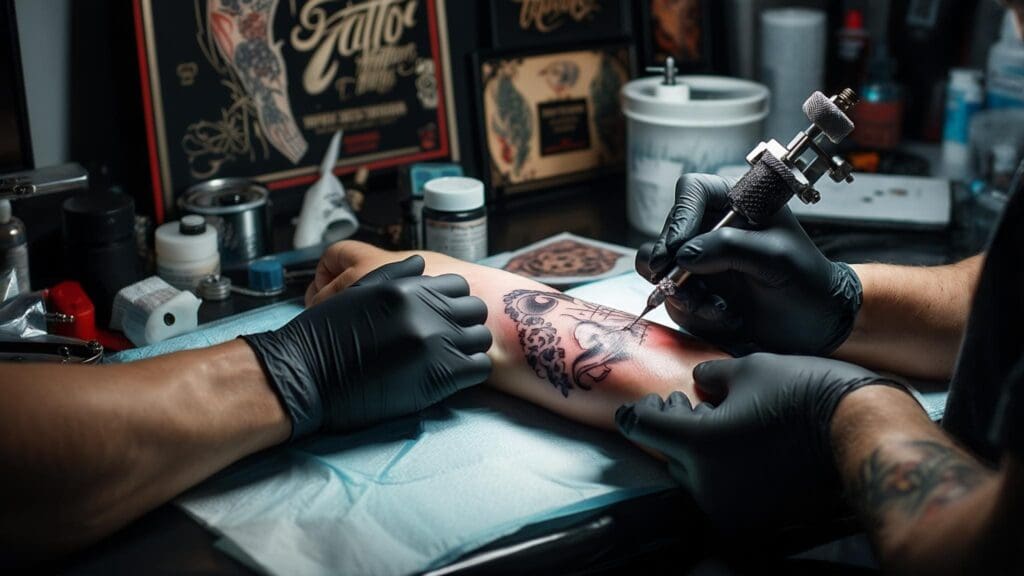
The tattoo industry’s apprenticeship landscape has evolved dramatically, with programs now ranging from $2,000 to over $10,000 depending on location and reputation, according to Certified Tattoo Academy. Yet despite these investments, most aspiring artists remain completely unprepared for the psychological, economic, and cultural realities that determine apprenticeship success.
Table of Contents
- The Emotional Minefield You’re Actually Walking Into
- Why Your Portfolio Isn’t Really About Your Art
- The Hidden Economics Behind Every Apprenticeship Decision
- How Social Media Changed Everything (And Most People Still Don’t Get It)
- The AI Revolution That’s Reshaping Apprentice Preparation
- Cracking the Code: How to Actually Get Noticed
- What Success Really Looks Like in Modern Apprenticeships
TL;DR
- Being good with people matters more than being good at art – you’ll face brutal rejection rates no matter how talented you are
- Every shop has unspoken rules and politics that actually determine who gets picked
- Your portfolio triggers gut reactions in people’s minds, not just “wow, nice art”
- Shops see apprentices as business investments with real money on the line and timelines to hit
- Social media gives you incredible ways to learn about shops that most people completely waste
- AI tools can speed up your learning when you use them right (but never submit AI work as your own)
- Getting an apprenticeship takes 3-6 months of actually getting to know people, not just dropping off portfolios
- Modern apprentices need to think like business owners, not just artists
The Emotional Minefield You’re Actually Walking Into
Look, I’ve seen some amazingly talented people get shot down over and over, while others who were just okay at drawing but great with people got apprenticeships pretty quickly. It’s frustrating, but that’s just how it works. The whole master-apprentice thing has turned into this tricky social game where reading the room, handling constant rejection, and not giving up matters way more than how well you can draw.
You need to get your head ready for massive rejection rates and complicated people stuff. Most people spend all their time perfecting their portfolio while completely ignoring the fact that they’re about to get told “no” about 98% of the time. Professional shops get 50-100 people asking for apprenticeships every month but only accept 1-2 apprentices per year. That rejection has nothing to do with your talent and everything to do with simple math.
Building Your Rejection Armor Before You Need It
Here’s what nobody tells you: every single person trying to get a tattoo apprenticeship will face brutal rejection rates no matter how good they are. The numbers are rough, and they’ll crush your spirit if you’re not ready for them.
| Rejection Reality Check | Statistics |
|---|---|
| Monthly applications per shop | 50-100 |
| Annual apprentice acceptances | 1-2 |
| Success rate | 2-4% |
| Emotional preparation time needed | 3-6 months |
| Average rejections before acceptance | 25-50 |
I recommend spending 3-6 months building up your mental toughness before you even start applying. This isn’t about developing thick skin – it’s about understanding that rejection in this industry works completely differently than other fields. When a shop says no, they’re usually making business decisions based on timing, how busy they are, and whether you’re a good fit rather than judging whether your art is any good.
Turning Every “No” Into Useful Information
Bouncing back stronger goes beyond just toughing it out. I’ve seen smart people turn rejection into a competitive advantage by really analyzing what happened. Each rejection gives you valuable information about what shops want, when they’re hiring, and what qualifications they’re looking for that you can use to improve your approach.
Rejection Analysis Checklist:
- Write down exactly why they said no
- Note what the vibe was like in the shop
- Record how the staff treated you
- Figure out if timing was an issue (busy season, staff changes)
- Write down any feedback you got on your portfolio
- Track whether they responded to follow-ups
- Notice what advantages other candidates had
Finding Gold in Closed Doors
Really analyzing your rejections means writing down every detail of every interaction to spot patterns in timing, reasons, shop atmosphere, and how staff acted. These patterns show you whether you’re targeting the wrong shops, showing up at bad times, or missing obvious things that could be easily fixed.
Understanding the financial side is crucial, as detailed in our comprehensive guide on how much tattoos cost, which helps people understand shop economics and pricing structures.
Sarah wrote down details from 30 rejections over four months and noticed that shops kept saying her portfolio didn’t have enough “traditional foundation work.” Instead of just feeling bad about it, she spent two months specifically studying American traditional techniques. Her next five applications got her three serious interviews and one apprenticeship offer, proving that really paying attention to feedback can turn it into a huge advantage.
Figuring Out the Invisible Shop Politics
Every tattoo shop runs on complicated unspoken hierarchies that go way beyond who’s officially in charge. The quiet artist in the corner might have more say in decisions than the person who seems to be running things. Understanding these hidden power structures takes careful observation and social smarts that most people completely miss.
Finding the Real Decision Makers
Shop owners often let senior artists or managers decide on apprenticeships. You need to figure out who these behind-the-scenes decision-makers are by watching carefully to see who defers to whom in conversations and whose opinions get the most response when you visit multiple times.
Watch body language during your visits. Who do people look to when important questions come up? Whose approval do other artists need before making decisions? These little clues reveal who really has the power.
Breaking Each Shop’s Cultural Code
Each shop develops its own unspoken rules about respect, how to communicate, and how to behave that can eliminate you before anyone even looks at your portfolio. Some shops like aggressive self-promotion while others prefer quiet competence. Learning to read the room is essential for apprenticeship success.
I’ve seen people get blacklisted from shops simply because they misread what was expected. One shop might appreciate direct, confident communication while another sees the same approach as disrespectful. You need to spend time watching before you start talking.
Why Your Portfolio Isn’t Really About Your Art
Your portfolio works like a psychological document that triggers gut reactions in the people looking at it through predictable mental shortcuts and hidden signals. Professional tattoo artists make split-second judgments based on how organized it is, how it’s presented, and little authority cues that work below conscious awareness but seriously influence whether they see you as credible.
Most people think their portfolio is about showing off their artistic ability. They’re wrong. Your portfolio is actually a tool for getting positive gut reactions that either makes people want to consider you or eliminates you before anyone even looks at your actual artwork.
Working With How Brains Actually Process Your Work
Human brains process visual stuff through predictable mental shortcuts that smart people can use strategically. People pay the most attention to the first and last pieces they see, and seeing subtle variations of similar themes makes you seem more competent.
Making Your Strongest Piece Work Overtime
Your strongest piece should be first to create a positive first impression that influences how people see everything else that comes after. This isn’t about putting things in chronological order but about psychological impact that makes your entire portfolio seem stronger through smart positioning.
I’ve watched people completely change how they were received by simply reordering their portfolios. The same artwork that got dismissed when it was buried in the middle suddenly got serious attention when placed strategically at the beginning.
Adding Credibility Signals That Bypass Logic
Professional evaluators respond to subtle authority signals including consistent presentation quality, using technical terms correctly, and referencing established artistic principles. These signals work below conscious awareness but seriously influence how credible and professional you seem.
Marcus reorganized his portfolio using the first-and-last-impression effect, putting his strongest traditional eagle piece first and his most technically complex geometric design last. Between visits, he added consistent matting and professional presentation sleeves. The same shops that previously dismissed his work suddenly wanted detailed discussions about his artistic development and technical approach, showing how presentation psychology beats pure artistic merit.
The Hidden Economics Behind Every Apprenticeship Decision
Apprenticeships aren’t charity – they’re complex business investments with detailed financial calculations balancing training costs, how long it takes to become productive, and long-term money-making potential. Understanding these economic realities helps you position yourself as a valuable investment rather than an expense.
Most apprenticeships last 1-2 years depending on the artist’s progress and mentor’s program structure, according to Certified Tattoo Academy, creating significant financial commitments that shops must carefully evaluate.
Every tattoo apprentice represents a massive financial gamble for shop owners. They’re not just being generous by offering training – they’re making calculated business decisions that need to pay off over time.
What Shops Really Spend on You
I’m going to give you some numbers that might freak you out, but I think you deserve to know what shops are actually spending on you. Beyond obvious costs like supplies and mentor time, shops invest in insurance increases, potential lost clients from apprentice mistakes, and the cost of experienced artists spending time teaching instead of tattooing. Understanding these hidden costs shows business maturity that separates serious candidates from people just playing around.
| Apprenticeship Investment Breakdown | Cost Range |
|---|---|
| Supplies and equipment | $2,000-4,000 |
| Mentor time opportunity cost | $15,000-25,000 |
| Insurance and liability increases | $1,200-2,400 |
| Lost revenue from mistakes | $3,000-8,000 |
| Administrative overhead | $1,500-3,000 |
| Total Investment | $22,700-42,400 |
When you see these numbers, you realize why shops are so picky. They’re not just choosing someone to teach – they’re choosing someone worth a $40,000 investment.
When You’re Expected to Start Making Money
Most shops expect apprentices to start bringing in money within 12-18 months through simple tattoos, selling merchandise, and helping maintain the shop. Showing that you understand this timeline and have a plan to contribute financially demonstrates business understanding that professional shops require from serious candidates.
You need to think about your apprenticeship as a business partnership from day one. What value can you bring beyond just learning? How will you help the shop get back their investment in you?
How Social Media Changed Everything (And Most People Still Don’t Get It)
The internet has completely changed apprenticeship hunting by giving you incredible access to shop culture, artist personalities, and insider information. Most people use these digital tools completely wrong. Social media is like an intelligence platform that can give you massive advantages when you use it right.
The industry keeps evolving with innovative programs like “Ink Different’s new Charlotte apprenticeship program featuring Ink Master celebrity Al Fliction” PRWeb, showing how social media visibility and celebrity connections are changing traditional tattoo apprenticeship paths.
Becoming a Digital Detective
Smart people use Instagram and Facebook like detectives. You can learn so much about a shop just by scrolling through their posts for 20 minutes – shop culture, artist personalities, busy seasons, and internal drama. This information helps with everything from when to approach them to what to talk about and whether you’d fit in culturally.
Reading Artists Like Open Books
Each artist’s social media shows you their personality traits, what kind of art they prefer, and how they like to communicate. This personality information helps you figure out whether they respond better to direct approaches or if they prefer you to build up to things gradually. Getting this wrong immediately eliminates you from consideration.
Timing Your Approach Like a Pro
Social media shows you shop rhythms including busy seasons, slow periods, staff changes, and major events that affect whether they’re receptive to apprentice inquiries. Approaching during slow periods increases your chances of getting attention while avoiding busy seasons prevents your inquiry from getting lost in operational chaos.
Understanding Unwritten Cultural Rules
Shop social media reveals cultural values, humor styles, and behavioral norms that vary dramatically between establishments. Some shops value irreverent humor while others maintain strict professional boundaries. Reading the room is essential for approach alignment.
Building Your Professional Online Presence
Your online presence should work like a 24/7 apprenticeship application showing professionalism, artistic development, and cultural fit. Most people either completely neglect their online presence or use it wrong , missing opportunities to stand out from the competition.
Crafting Your Professional Brand
Your online brand should reflect the professional artist you’re becoming rather than the amateur you currently are. This requires choosing content that shows a growth mindset, respect for tattoo culture, and commitment to professional development that appeals to potential mentors.
The AI Revolution That’s Reshaping Apprentice Preparation
Modern tattoo shops increasingly use digital tools for design, client consultation, and business management, making tech literacy essential for apprentice success. AI and digital tools represent revolutionary training opportunities that speed up artistic development when used strategically rather than as replacement for traditional skills.
Okay, so AI tattoo stuff is actually pretty cool for learning. I know some old-school people hate it, but hear me out – you can mess around with different styles and see how they work without wasting hours drawing the same thing over and over.
Using AI to Speed Up Your Learning
AI tattoo generators are revolutionary training tools that let you explore styles, understand design principles, and develop visual vocabulary at crazy speed. Instead of replacing artistic skill, these tools speed up learning and expand creative possibilities for better-prepared candidates.
Modern technology offers powerful resources, with comprehensive reviews of the best AI tattoo generators helping people understand which tools provide the most educational value for artistic development and style exploration.
Exploring Thousands of Design Variations Instantly
Traditional design development takes hours per try, which seriously limits how much you can explore. AI tools let you rapidly go through hundreds of design variations. This speed helps you understand style relationships, composition principles, and artistic possibilities that would take months to explore manually.
Breaking Down Artistic Traditions Through Technology
AI platforms give you instant access to authentic representations of traditional, neo-traditional, geometric, and realistic styles. This helps you develop sophisticated understanding of style characteristics, historical context, and technical requirements that inform better artistic development and cultural knowledge.
Enhancing Your Portfolio Preparation (Not Replacing It)
AI-generated designs work as study materials and inspiration sources but never as portfolio submissions. Smart people use AI tools to understand composition principles, explore style variations, and develop visual vocabulary that informs original artwork creation.
Building Comprehensive Visual Libraries
Generate hundreds of style variations to understand subtle differences between traditional American, Japanese, and neo-traditional approaches. This provides visual education that speeds up artistic development by offering instant access to style characteristics that would take years to encounter naturally.
Rapid Concept Prototyping
Use AI tools to explore multiple approaches to client concepts quickly, understanding how different styles interpret similar themes to develop artistic flexibility and learn to think like professional tattoo artists who must adapt concepts to various stylistic approaches.
Jennifer used AI tools to generate 200 variations of rose designs across different styles, analyzing how traditional, neo- traditional, and realistic approaches handle the same subject matter. This visual education helped her understand style fundamentals that took her mentor years to learn naturally, allowing her to contribute meaningfully to design discussions during her apprenticeship interviews and demonstrate sophisticated artistic understanding that impressed potential mentors.
Cracking the Code: How to Actually Get Noticed
Most people approach shops randomly with generic inquiries. Smart apprenticeship hunters use systematic processes that dramatically increase success rates through strategic targeting, timing, and relationship building over predictable timelines spanning months rather than minutes.
I’ve watched hundreds of people fail because they treat apprenticeship hunting like job applications. They walk into shops, hand over portfolios, and expect immediate responses. This approach fails 98% of the time because it completely misunderstands how the industry works.
Strategic Shop Research and Targeting
Successful apprentices target 5-10 shops maximum with deep research on each rather than mass-applying to every local establishment. This focused approach allows for personalized outreach demonstrating genuine interest and cultural fit that separates serious candidates from desperate mass-applicants.
When you’re learning how to become a tattoo apprentice, quality beats quantity every single time. I’ve seen people apply to 50 shops and get nowhere, while others research 5 shops intensively and land multiple interviews.
Matching Your Style to Shop Specialties
Look at each shop’s artist portfolios to figure out what styles they prefer, their technical standards, and artistic philosophies. Shops specializing in traditional work rarely accept apprentices focused on realism while geometric specialists may not appreciate watercolor approaches.
Understanding Market Positioning
High-end custom shops need different apprentice qualities than walk-in focused establishments. Understanding market position is essential for emphasizing relevant skills and experiences that align with specific business needs and client expectations when learning how to become a tattoo apprentice.
The 3-6 Month Relationship Building Timeline
Professional apprenticeship acquisition follows predictable timelines spanning months of relationship building before formal application. This allows natural rapport development and demonstrates serious commitment that separates genuine candidates from impulsive inquirers seeking instant gratification.
Look, I know 3-6 months sounds like forever when you’re excited to start, but trust me on this. You can’t just walk into a shop and expect them to take you seriously. These people need to know you’re not going to flake out after two weeks when you realize how hard this actually is.
Relationship Building Timeline:
- Month 1-2: Regular shop visits as paying customer
- Month 2-3: Attend shop events and build recognition
- Month 3-4: Offer value through social media help or administrative tasks
- Month 4-5: Deepen relationships through consistent presence
- Month 5-6: Natural progression to apprenticeship discussion
- Month 6+: Formal application with established relationships
Phase One: Becoming a Familiar Face
Visit shops regularly as a paying customer, attending events and supporting artists through merchandise purchases to build recognition and demonstrate genuine appreciation for tattoo culture beyond personal gain. You need to establish yourself as part of the community rather than an outsider seeking favors.
Phase Two: Contributing Value Before Asking
Offer help with social media, event organization, or administrative tasks that showcase professional skills and work ethic while providing real value before requesting apprenticeship consideration. This demonstrates business understanding and community investment.
Phase Three: The Natural Progression
After months of relationship building, formal applications get serious consideration rather than immediate dismissal because your application becomes a natural progression of existing relationships rather than cold outreach from unknown individuals.
Understanding pain management is crucial for client relations, and our detailed tattoo pain scale guide helps candidates better communicate with clients about comfort and expectations during the tattooing process.
What Success Really Looks Like in Modern Apprenticeships
Traditional apprenticeships focused primarily on technical skill development, but modern programs evaluate apprentices across multiple dimensions including business smarts, client relations, and digital marketing capabilities that extend far beyond artistic ability alone.
Most apprentices don’t get paid in the beginning and may only earn a small amount once they start tattooing clients under supervision, according to Certified Tattoo Academy, making financial planning essential for apprenticeship success.
The definition of success has completely shifted in recent years. Being a talented apprentice isn’t enough anymore – you need to think and act like a business owner from day one.
Technical Milestones You Need to Hit
Successful apprentices reach specific technical milestones within predictable timeframes including clean line work within 3 months, basic shading within 6 months, and simple designs within 12 months. Understanding these benchmarks helps set realistic expectations and track meaningful progress.
Here’s roughly what you should be able to do and when. Don’t panic if you’re a little behind – everyone learns at their own pace. But if you’re way off track, you need to figure out what’s going wrong.
Technical Milestone Checklist:
- Month 1-3: Clean, consistent line work on practice skins
- Month 3-6: Basic black and gray shading techniques
- Month 6-9: Color theory and saturation control
- Month 9-12: Simple flash designs on live clients
- Month 12-18: Custom design consultation and execution
- Month 18-24: Independent client management and portfolio building
Business Integration Beyond Art
Modern apprentices must demonstrate business understanding through client consultation skills, appointment management, and revenue generation because shops evaluate apprentices as future business partners rather than just artists in training.
Programs like “Ink Different’s Master Mentorship Program featuring established and celebrity tattoo artists” PRWeb emphasize comprehensive training in “industry professionalism, shop etiquette, client communication, and portfolio development,” reflecting the modern expectation that apprentices master business skills alongside artistic techniques.
The apprenticeship program structure has evolved to include business training because shops need apprentices who can contribute to profitability, not just create art.
Managing Client Relationships Professionally
Apprentices handle initial client consultations, manage appointment scheduling, and provide aftercare guidance, requiring professional communication skills that extend far beyond artistic ability and demonstrate readiness for independent practice.
Proper aftercare education is essential for client relations, and understanding tattoo aftercare secrets helps candidates provide comprehensive client support that demonstrates professional competence and builds trust with both clients and mentors.
Contributing to Shop Revenue
Successful apprentices contribute financially through merchandise sales, consultation fees, and eventually simple tattoo work. Understanding revenue expectations is essential for preparing for business realities beyond artistic development.
David’s apprenticeship required him to manage the shop’s Instagram account, respond to consultation requests, and schedule appointments for three artists. Within six months, his professional communication skills and social media management increased shop bookings by 30%, demonstrating business value that led to faster progression through technical milestones and earlier client work opportunities.
For apprentice seekers looking to accelerate their artistic education and develop the cultural understanding that modern apprenticeships demand, platforms like Tattoo Generator IQ offer advanced AI generation combined with educational resources. The platform’s professional-grade outputs and comprehensive learning materials help create better-prepared candidates who arrive at shops ready for meaningful artistic collaboration and business contribution.
Final Thoughts
Look, I’m not going to lie to you – this path isn’t easy, and it’s not fair. Some amazingly talented people never get their shot, while others seem to fall into it. But if you go in with your eyes open, do your homework, and stick with it even when it sucks, you’ve got a real chance. The tattoo world needs good people who actually care about doing this right.
Breaking into the tattoo industry through apprenticeship isn’t just about artistic talent – it’s about understanding the complex psychological, economic, and cultural realities that drive modern shop operations. The apprentices who succeed are those who approach the process strategically, building genuine relationships over months while developing both artistic skills and business smarts.
The digital age has created new opportunities for preparation and relationship building, but it’s also raised the bar for what shops expect from serious candidates. You can’t just show up with a portfolio anymore – you need emotional intelligence, the ability to read the room, and business understanding that demonstrates you’re ready to contribute to shop success from day one.
Remember, every “no” you receive contains valuable information about the market, timing, and your approach. Use that information strategically, stay persistent but respectful, and focus on building genuine connections within the tattoo community. The apprenticeship will come when you’ve proven yourself worthy of the investment shops are making in your future.
And yeah, it’s annoying that you have to basically hang around for months before anyone will even consider you. It feels like playing games, and maybe it is. But that’s how this world works, and fighting it won’t get you anywhere. By the way, every shop is different, so don’t take any of this as gospel. Use it as a starting point, but pay attention to what you’re seeing in your own area.


